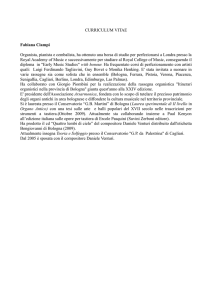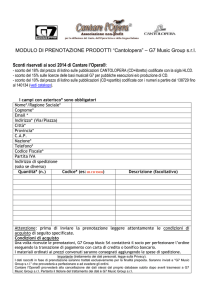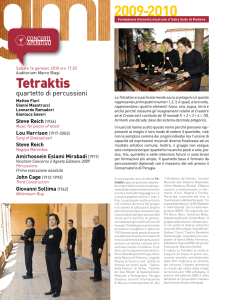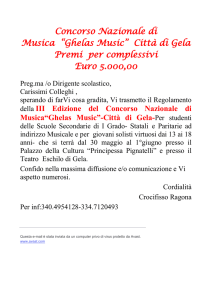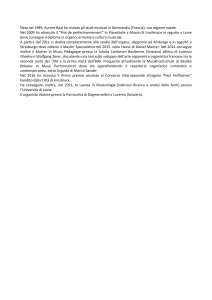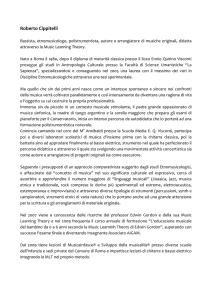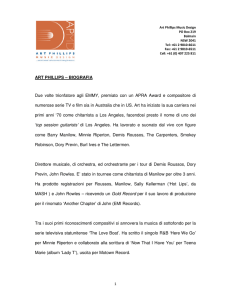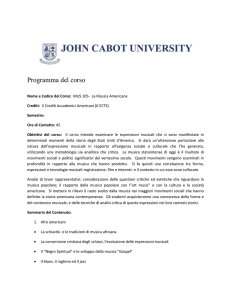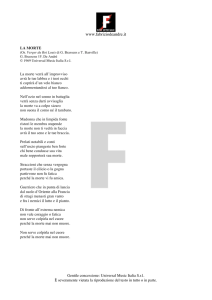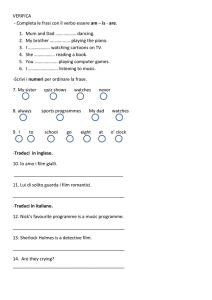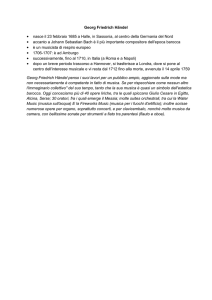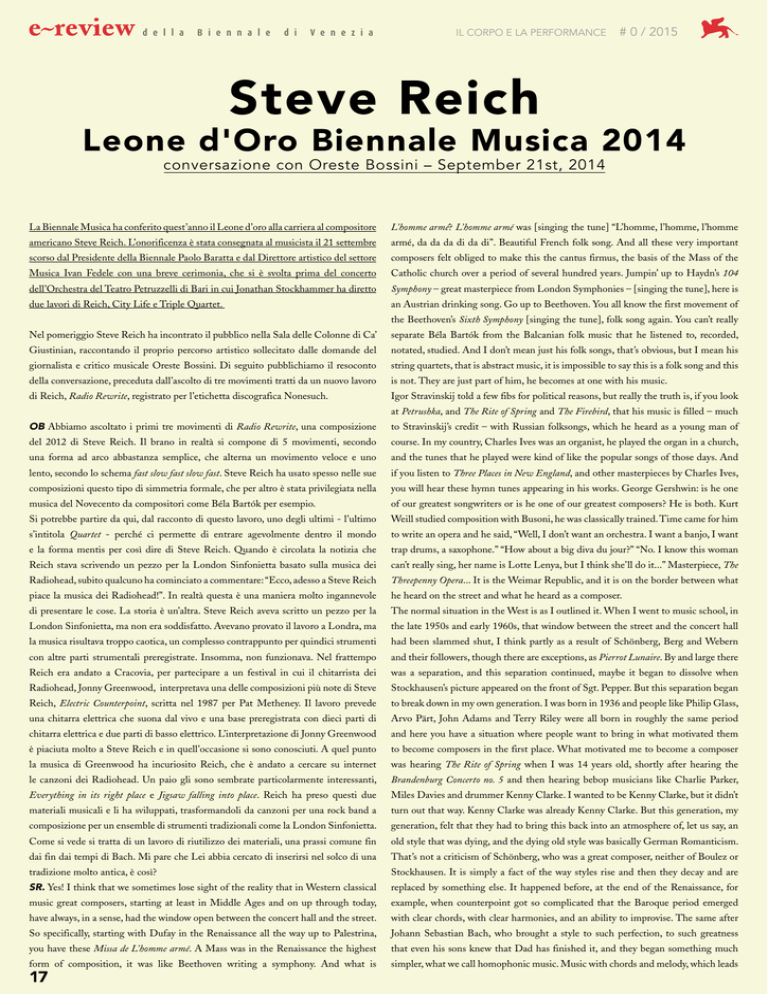
d e l l a
B i e n n a l e
d i
V e n e z i a
IL CORPO E LA PERFORMANCE # 0 / 2015
Steve Reich
Leone d'Oro Biennale Musica 2014
conversazione con Oreste Bossini – September 21st, 2014
La Biennale Musica ha conferito quest’anno il Leone d’oro alla carriera al compositore
L’homme armé? L’homme armé was [singing the tune] “L’homme, l’homme, l’homme
americano Steve Reich. L’onorificenza è stata consegnata al musicista il 21 settembre
armé, da da da di da di”. Beautiful French folk song. And all these very important
scorso dal Presidente della Biennale Paolo Baratta e dal Direttore artistico del settore
composers felt obliged to make this the cantus firmus, the basis of the Mass of the
Musica Ivan Fedele con una breve cerimonia, che si è svolta prima del concerto
Catholic church over a period of several hundred years. Jumpin’ up to Haydn’s 104
dell’Orchestra del Teatro Petruzzelli di Bari in cui Jonathan Stockhammer ha diretto
Symphony – great masterpiece from London Symphonies – [singing the tune], here is
due lavori di Reich, City Life e Triple Quartet.
an Austrian drinking song. Go up to Beethoven. You all know the first movement of
the Beethoven’s Sixth Symphony [singing the tune], folk song again. You can’t really
Nel pomeriggio Steve Reich ha incontrato il pubblico nella Sala delle Colonne di Ca’
separate Béla Bartók from the Balcanian folk music that he listened to, recorded,
Giustinian, raccontando il proprio percorso artistico sollecitato dalle domande del
notated, studied. And I don’t mean just his folk songs, that’s obvious, but I mean his
giornalista e critico musicale Oreste Bossini. Di seguito pubblichiamo il resoconto
string quartets, that is abstract music, it is impossible to say this is a folk song and this
della conversazione, preceduta dall’ascolto di tre movimenti tratti da un nuovo lavoro
is not. They are just part of him, he becomes at one with his music.
di Reich, Radio Rewrite, registrato per l’etichetta discografica Nonesuch.
Igor Stravinskij told a few fibs for political reasons, but really the truth is, if you look
at Petrushka, and The Rite of Spring and The Firebird, that his music is filled – much
OB Abbiamo ascoltato i primi tre movimenti di Radio Rewrite, una composizione
to Stravinskij’s credit – with Russian folksongs, which he heard as a young man of
del 2012 di Steve Reich. Il brano in realtà si compone di 5 movimenti, secondo
course. In my country, Charles Ives was an organist, he played the organ in a church,
una forma ad arco abbastanza semplice, che alterna un movimento veloce e uno
and the tunes that he played were kind of like the popular songs of those days. And
lento, secondo lo schema fast slow fast slow fast. Steve Reich ha usato spesso nelle sue
if you listen to Three Places in New England, and other masterpieces by Charles Ives,
composizioni questo tipo di simmetria formale, che per altro è stata privilegiata nella
you will hear these hymn tunes appearing in his works. George Gershwin: is he one
musica del Novecento da compositori come Béla Bartók per esempio.
of our greatest songwriters or is he one of our greatest composers? He is both. Kurt
Si potrebbe partire da qui, dal racconto di questo lavoro, uno degli ultimi - l’ultimo
Weill studied composition with Busoni, he was classically trained. Time came for him
s’intitola Quartet - perché ci permette di entrare agevolmente dentro il mondo
to write an opera and he said, “Well, I don’t want an orchestra. I want a banjo, I want
e la forma mentis per così dire di Steve Reich. Quando è circolata la notizia che
trap drums, a saxophone.” “How about a big diva du jour?” “No. I know this woman
Reich stava scrivendo un pezzo per la London Sinfonietta basato sulla musica dei
can’t really sing, her name is Lotte Lenya, but I think she’ll do it...” Masterpiece, The
Radiohead, subito qualcuno ha cominciato a commentare: “Ecco, adesso a Steve Reich
Threepenny Opera... It is the Weimar Republic, and it is on the border between what
piace la musica dei Radiohead!”. In realtà questa è una maniera molto ingannevole
he heard on the street and what he heard as a composer.
di presentare le cose. La storia è un’altra. Steve Reich aveva scritto un pezzo per la
The normal situation in the West is as I outlined it. When I went to music school, in
London Sinfonietta, ma non era soddisfatto. Avevano provato il lavoro a Londra, ma
the late 1950s and early 1960s, that window between the street and the concert hall
la musica risultava troppo caotica, un complesso contrappunto per quindici strumenti
had been slammed shut, I think partly as a result of Schönberg, Berg and Webern
con altre parti strumentali preregistrate. Insomma, non funzionava. Nel frattempo
and their followers, though there are exceptions, as Pierrot Lunaire. By and large there
Reich era andato a Cracovia, per partecipare a un festival in cui il chitarrista dei
was a separation, and this separation continued, maybe it began to dissolve when
Radiohead, Jonny Greenwood, interpretava una delle composizioni più note di Steve
Stockhausen’s picture appeared on the front of Sgt. Pepper. But this separation began
Reich, Electric Counterpoint, scritta nel 1987 per Pat Metheney. Il lavoro prevede
to break down in my own generation. I was born in 1936 and people like Philip Glass,
una chitarra elettrica che suona dal vivo e una base preregistrata con dieci parti di
Arvo Pärt, John Adams and Terry Riley were all born in roughly the same period
chitarra elettrica e due parti di basso elettrico. L’interpretazione di Jonny Greenwood
and here you have a situation where people want to bring in what motivated them
è piaciuta molto a Steve Reich e in quell’occasione si sono conosciuti. A quel punto
to become composers in the first place. What motivated me to become a composer
la musica di Greenwood ha incuriosito Reich, che è andato a cercare su internet
was hearing The Rite of Spring when I was 14 years old, shortly after hearing the
le canzoni dei Radiohead. Un paio gli sono sembrate particolarmente interessanti,
Brandenburg Concerto no. 5 and then hearing bebop musicians like Charlie Parker,
Everything in its right place e Jigsaw falling into place. Reich ha preso questi due
Miles Davies and drummer Kenny Clarke. I wanted to be Kenny Clarke, but it didn’t
materiali musicali e li ha sviluppati, trasformandoli da canzoni per una rock band a
turn out that way. Kenny Clarke was already Kenny Clarke. But this generation, my
composizione per un ensemble di strumenti tradizionali come la London Sinfonietta.
generation, felt that they had to bring this back into an atmosphere of, let us say, an
Come si vede si tratta di un lavoro di riutilizzo dei materiali, una prassi comune fin
old style that was dying, and the dying old style was basically German Romanticism.
dai fin dai tempi di Bach. Mi pare che Lei abbia cercato di inserirsi nel solco di una
That’s not a criticism of Schönberg, who was a great composer, neither of Boulez or
tradizione molto antica, è così?
Stockhausen. It is simply a fact of the way styles rise and then they decay and are
SR. Yes! I think that we sometimes lose sight of the reality that in Western classical
replaced by something else. It happened before, at the end of the Renaissance, for
music great composers, starting at least in Middle Ages and on up through today,
example, when counterpoint got so complicated that the Baroque period emerged
have always, in a sense, had the window open between the concert hall and the street.
with clear chords, with clear harmonies, and an ability to improvise. The same after
So specifically, starting with Dufay in the Renaissance all the way up to Palestrina,
Johann Sebastian Bach, who brought a style to such perfection, to such greatness
you have these Missa de L’homme armé. A Mass was in the Renaissance the highest
that even his sons knew that Dad has finished it, and they began something much
form of composition, it was like Beethoven writing a symphony. And what is
simpler, what we call homophonic music. Music with chords and melody, which leads
17
d e l l a
B i e n n a l e
d i
IL CORPO E LA PERFORMANCE V e n e z i a
# 0 / 2015
to Haydn, Mozart and Beethoven, and a whole new style of music which then goes
abbastanza semplice. Reich non usa in genere un vocabolario armonico molto
all the way to Wagner and to Schönberg and so on. So this is not something new. As
complesso, contrappunti particolarmente complicati. Spesso lavora su rapporti tonali
a matter of fact, the young composer David Lang, good friend of mine, one of the
elementari, per esempio tonica, dominante, sottodominante. Questi vecchi vocaboli
founders of Bang on a Can, a multi-faceted contemporary music organization based
però riescono a essere recuperati in una dimensione completamente nuova, questo è
in New York, once said to me “I envy you when you were born.” And what he meant
l’aspetto geniale della musica di Steve Reich. Mi viene in mente quello che poco prima
was that I was born at a time when it was necessary and possible to do this. You can’t
Lei ha detto a proposito di Kenny Clarke, questo grande batterista, che non è stato il
just say “Hey kids! Let’s have a new style of music!”, that’s childish. “Hey kids! Let’s
più grande virtuoso della storia del jazz. Max Roach e Art Blakey erano sicuramente
have a new religion!”, that’s not how human life works. These things happen at a
strumentisti capaci di fare cose molto più esplosive, molto più spettacolari dal punto
certain time in history when something, as I said, is dying and people just feel like
di vista tecnico. Però Kenny Clarke, con il vocabolario ritmico abbastanza ridotto in
there’s something we’ve got to clean up: “Give me a broom! This place is a mess!”. If I
suo possesso, riusciva sempre a dare l’impressione immediata dell’originalità della sua
wasn’t born, if Pärt or Riley wasn’t born, somebody would have come along and done
musica. Ascoltando la sua maniera di suonare riconoscevi subito “Questo è Kenny
that, because it needed to be done. Radio Rewrite is merely one small example of that.
Clarke!”. Non so se il paragone possa essere accettato da Steve Reich.
OB. Visto che stiamo parlando di musica, rimaniamo su un lavoro come Radio
SR. I think this is exaggerated, in a way! Harmonically, if you listen to The Desert
Rewrite. Mi sembra che il motivo per cui Lei ha scelto queste due canzoni dei
Music (1983), or Sextet which followed, you’ll find a much more chromatic harmony.
Radiohead è per un certo tipo di qualità armonica, per certe caratteristiche
If you listen to the beginning of Daniel Variations, you hear a chord that is really
dell’armonia. Questo forse ci aiuta a capire quanto sia stato importante per Lei, e
very very dissonant. I played you a piece which is very very consonant, and I love
più in generale per la sua generazione di musicisti americani, aver riportato in primo
it, but it isn’t the only thing that I have ever done. I have used chromatic harmony
piano il problema dell’armonia.
in a number of pieces. Kenny Clarke... I was 14 years old and I had never heard any
music before Haydn, and no music after Wagner, so hearing Bach was a complete
SR. When I was listening as a student to Schönberg, Berg and Webern and then,
revelation. Hearing Stravinskij and bebop was a complete revelation! I heard popular
much later, to the earlier works of Boulez and Stockhausen, three things are missing.
music of the day, and yes, there were two main bebop drummers: Max Roach, great
There doesn’t seem to be any harmonic centre, there doesn’t seem to be anything that
drummer, and Kenny Clarke, also a great drummer. The difference between them
you could possibly whistle or sing, there was no perceptible rhythm. Despite the fact
was that Max Roach was a more virtuosic player, he could do more things, and Kenny
that Schönberg said “in fifty years every postman will be whistling my tunes”, in over
Clarke had a magic quality of time. I also explained to you that Kenny Clarke was
a hundred years there’s not a postman in sight. It’s not because Schönberg wasn’t a
also a great innovator, which I didn’t even know. One of percussionists in my own
great composer, it’s because he had a strange delusion about what he was doing and
ensemble, Russell Hartenberger by name, was doing some research into Kenny Clark.
you couldn’t tap your foot. Now, if you remove from any music, Western or non-
It turns out that any jazz drummer before Kenny Clarke, I mean in the 1930s, played
Western, any sense of what Stravinskij called the “polar attraction” of sound, then you
like this [crossing arms], they keep time on the hi-hat and throw in accents on their
have in a sense thrown the baby out with the bath water. I’m not talking necessarily
snare drum with the right. Kenny Clarke he put his right hand on the right cymbal
about the authentic perfect cadence at the basis of Western music, but some way of
and he invented for those playing jazz drums “din din didin, din didin...”. When I
harmonic attraction. It’s not just making something new, it’s taking out essentials.
started studying drums in the 1950s I thought that pattern fell down from heaven.
The harmonic series appears in nature, the intervals of the octave and the fifth appear
You know, it was just the way you play the right cymbal. But it didn’t fall down from
in every music all over the planet. So, what you say is certainly true, but it’s only part
heaven, Kenny Clarke invented it. So it’s not a surprise that he played it with this
of the picture. In other words, not only harmony, but rhythm was disregarded and
floating. It’s as if the entire band rode effortlessly on this buoyant time. That struck
it was to these missing basics that I and others in my generation returned to. To
me as a great gift that he had, which he could then support others with. I don’t know
answer this particular... One of tunes is called Everything in its right place, from Kid
if any of my pieces have it, but I think that it floats over some of the early pieces like
A album. It’s the most complicated three-chord rock around, right? What got me
Drumming and maybe in another sense the constant pulse of Music for 18 Musicians.
about the tune is that. I don’t know if Jonny Greenwood really wrote it, but I saw
I rarely think about Kenny Clarke. But outside of that it’s something which really
a video of him singing at piano and he was completely into it. Now, everything in
belongs to my early teens and it certainly was formative. And he’s certainly a great
Western music can be reduced in a sense to “one five one” cadence, every Beethoven
drummer.
symphony. If you wanted to say, “well, what’s the nitty-gritty, the very very basic?”. It’s
OB. Tornando un momento indietro, a proposito di manipolazione del materiale
the dominant going to the tonic, and then all the subdivisions of the harmonic path.
musicale, e in particolare di manipolatori di musica popolare, ci sarebbe un altro
This line – [singing the tune] “Everything...” – was just it struck me so, you hit it
nome, oltre a quelli fatti prima da Steve Reich, che non dovrebbe essere dimenticato,
on the head. So I used that phrase, that melodic phrase. The harmony is so powerful
ed è quello di Luciano Berio naturalmente. Berio è stato anche uno dei maestri di
in that tune that I tried to reverse the order of the chords. The other tune, “Jigsaw
Reich in California, al Mills College, negli anni Sessanta. Questo mi offre lo spunto
Falling into Place”, it was the harmony which you hear at the very beginning of my
per chiedere qualcosa sul loro rapporto. Berio l’ha incoraggiata a concepire in maniera
piece somewhat elaborated. What pops up either clearly or not so clearly, if you heard
così libera la musica?
the whole piece, it’s fast slow fast slow fast, which is “Jigsaw – Everything – Jigsaw
SR. Indirectly, yes. I first heard Luciano Berio in New York City while I was a student
– Everything – Jigsaw”. In the Jigsaw sections, harmony is either obvious or not so
at the Juilliard School, and Berio gave a concert downtown at the New School. The
obvious. But, yes, I think a lot of musicians in my generation, and in generations
major piece in the program was a piece of his called Circles, it’s a setting of the poet
that followed, some of them have picked up classic passacaglia lines, the descending
E. E. Cummings. The first word is stinging, like a bee. He was then married to Cathy
scale lines that appear throughout the early baroque and before; they have revitalised
Berberian, the great singer, who was his first wife, and she sang “SSStiiiiiIIIngING”
them and brought them back. So, I think that what we did is not a revolution, it’s a
and then she’s holding at the “ssss”. He’s got a percussionist with sandpaper blocks,
restoration. I would say, a restoration of harmony and rhythm in a new way.
shhhhh, rubbing them together. And I’m thinking: “Wow, he’s imitating the sound
OB. Ecco, restaurazione del ritmo e dell’armonia in una maniera nuova. Mi sembra
of her consonants with the percussion instrument. Thank you very much.” I was
un concetto interessante, ancora da approfondire. In effetti nella musica di Steve
getting a lesson right away and I wasn’t even his student. I left the Juilliard in 1961
Reich, non soltanto in questo pezzo, ma anche nella sua musica precedente, si vede
and I went out to the West Coast. He was at Mills college, I worked with him from
come l’autore riesca a conferire una nuova freschezza a un linguaggio armonico
1961 to 1963, I guess, and he was at that time working on a piece called Omaggio
18
d e l l a
B i e n n a l e
d i
V e n e z i a
IL CORPO E LA PERFORMANCE # 0 / 2015
a Joyce, as in James Joyce. He was taking Finnegans Wake, which no one can even
armonico. Una staticità che diventava allo stesso tempo di enorme complessità, grazie
read, and he’d have Cathy Berberian read parts of it, then he’d cut it up. This is in
al fatto che le pulsazioni ritmiche si sfasavano poco alla volta in maniera lentissima,
the days of tape, do you remember tape? You could actually cut up the plastic tape,
creando quindi dei contrappunti ritmici assolutamente imprevedibili, o per meglio
and he would make this very abstract kind of all these phonemes put together, out
dire incalcolabili nella musica occidentale, che ha un’origine matematica e quindi
of her readings. He also, as a teacher, said to us as a class: “Ok, I’m going to play
sottoposta a un ferreo criterio di divisibilità.
two recordings of Karlheinz Stockhausen. The first one is called Electronic Studies.
SR. Yes. You left out two important names, one of them is Béla Bartók and the other
The second one is called Gesang der Jünglinge. Why? Because it’s a kid’s voice.” And
is Perotin. Perotin is from the XII century, the School of Notre Dame in Paris. You
right away my ear went... the voice is attracting my ear. Basically, what I think that
all go to your music dictionaries, if you don’t know who that is. If you’re lucky, get a
I got from Berio – very very far from what Berio himself did – was the idea that if
hold of the recording on ECM made by Paul Hillier of the four-part Organa, and
I’m going to make electronic music, I don’t want to use electronic sounds, I want to
if that doesn’t give you a boost, too bad! So, John Coltrane. John Coltrane had an
use sounds from this world and, particularly, humans’ speech. And indeed, if any of
enormous influence on me, you are absolutely right. I first started listening to John
you know my own It’s Gonna Rain, this proved to be very fruitful, and it went on
Coltrane while I was at Juilliard, in about 1960–1961, and then when I moved out
years later into pieces like Different Trains, where I took the human speaking voice
to the West Coast I started to hear him regularly. Berio during the day, Coltrane
and combine it with musical instruments. And this led to The Cave and Three Tales
during the night. Not a bad way to spend your life. I must have heard him at least
which was my contribution to opera. It’s not an opera, it’s music theater, but whereby
fifty times in San Francisco, I heard him play with Eric Dolphy. Now, the piece that
video tape interviews done by Beryl Korot, the great video artist whose work is on
you are referring to is Africa/Brass. What’s significant about Africa/Brass is that it’s
view at the Tate Modern as we speak, are being projected on five different screens
about 16–17 minutes long and it’s all on the low E of the double bass. You know
and a whole ensemble of musicians – woodwinds, percussions, strings, keyboards –
how jazz musicians talk to each other. “Hey man, what’s the changes? What’s the
are playing their speech melody. Sometimes when we speak, we almost sing. Kids’
changes to Africa/Brass?” “E.” “No, no, no... what’s the changes?” “E.” “E??? E for 16
larynxes aren’t too developed. When I was in England a guy played me a tape and
minutes?!” Now that sounds like a one-way ticket to boredom. Thank you very much,
his kid said: “Daddy, I want an ice cream!”, and it was so perfectly melodic that he
I gotta leave now. So how does he make it work? Well, first of all he was working
could have made a piece, but he didn’t. Speech melody is something that’s human
with Eric Dolphy, who was a brilliant alto sax player and who introduced the bass
reality. Janácek has nothing to do with our story so far… I was giving a little talk at
clarinet into jazz and from whom I stole the idea of using the bass clarinet in Music
the Juilliard School of Music shortly after I wrote Different Trains, which uses speech
for 18 Musicians. Those wonderful froggy sounds that are in Music for 18 Musicians
melody, and there was an elderly European gentleman, obviously an elderly faculty
are a direct steal from Eric Dolphy. What Dolphy did for Coltrane, since Africa/Brass
person that I did not know. He raised his hand and he said to me “Do you know
does have a large brass section, was that he wrote glissandos for the French horn,
the writings of Leós Janácek?”. I said: “No, I’m terribly sorry, I don’t”. “Well, you
which sound like elephants coming through the jungle. Then Coltrane himself is
should!” So I thought: “This man is telling me something” and I bought the book,
playing, mostly soprano saxophone. Sometimes he’s playing just gorgeous melodic
called The Uncollected Writings of Leós Janácek. One of the articles is all about speech
material, sometimes he is just screaming through the instrument, pure noise. And
melody. He says some beautiful things, he says that speech melody is like the water-
more, in terms of rhythm, there is Elvin Jones, the drummer, who was probably
lily on top of the water and its roots go down right into the human soul. I mean,
the most polyrhythmic, most complicated drummer to play jazz, or he’s certainly
that’s a beautiful and true thought. I mean, think of a recording of your voice and a
a candidate for that. So, if you put together timbral variety, rhythmic complexity,
photo of you. Which is more real? Who’s to say? Janácek used to walk around with a
melodic invention, then you can stay rooted on E and its E minor for 16–17 minutes
music notebook, writing down not what people sang, but what they said. They were
and be riveted, because what you’re not getting harmonically, you are getting from
speech melodies and then these speech notes would appear in his operas. He even
all these other musical factors. They are highlighted and accentuated by the fact that
transcribed a train conductor in Czechoslovakia, when there was a Czechoslovakia,
the harmony is relatively static. It isn’t completely static, it’s constantly changing its
in ’20s. Every educated person had to learn German and Janácek, being a nationalist,
voicings and so on and so forth. This was a kind of object lesson that was in the air
hated that. And he compared the way this train conductor announced the station first
in the 1960s. You all know The Beatles were listening to Indian music; they weren’t
in German, with a major seventh, and then in Czech in his beautiful broken triad.
the only ones. Phil Glass was listening to Indian music, Terry Riley was listening to
So the idea of transcribing the way people speak and seeing that as part of the music.
Indian music, I was very interested in West African drumming. I went to Ghana
Why is it here in Italy, in your country, “Ooo-peee-raa”? Of course opera is going to
and studied drumming there. I went to study Balinese gamelan, playing with two
come from a language like that, while rock and roll is going to come from English or
different kinds of gamelan on the West coast in the United States, in the summers of
German. Because languages really do contribute to the musicality of the composers
1973 and 1974. In Motown label in that period there was a guy by the name of Junior
who write them. It’s just in our guts.
Walker. He released a single called Shotgun. What was distinctive about it, was that
OB. What about Wagner?
the bass line went on waiting for the change, but there isn’t any change. The whole
SR. Wagner was a German, to the core!
side of a record. Usually, every pop tune is based on a form A-B-A, and then you’ve
OB. Un pezzetto alla volta stiamo mettendo insieme i vari pezzi del mondo musicale
got the release, and you go back. No, just this repeating bass line. So here you have
da cui proviene Steve Reich. Ci sono alcuni tasselli, però, che ancora mancano, uno in
music coming in from non-Western sources recorded on the Nonesuch label, which
particolare piuttosto importante, John Coltrane. Possiamo forse indicare una triade,
I’m signed with, and many other labels. You have live musicians like Ravi Shankar
Bach, John Coltrane e Stravinskij, per capire quali sono le radici della musica di Steve
touring around and playing. You have recordings of Balinese music, West African
Reich. Il Coltrane dell’ultima fase, naturalmente, quello dei primi Anni Sessanta,
music, other forms of Indian music from the South and North, of Japanese gagaku
non il Coltrane bebop. L’ultimo Coltrane riusciva a creare delle strutture musicali
and on and on and on. Harmonic stasis was in the air. So if musicians have their
di incredibile pienezza, rimanendo ancorato su un singolo accordo per una quantità
headphones on and their antennae up, and they are listening to the same stations,
di tempo che ai jazzisti di allora sembrava inverosimile. Lui e i suoi musicisti erano
they are going to receive these signals and to start thinking about these sources,
capaci d’improvvisare per venti minuti su un accordo di mi maggiore. Era una cosa
which are so different, so diametrically opposed to Schönberg, Berg, Webern, Boulez,
a quel tempo impressionante e rivoluzionaria. Non so se questo tipo di approccio
Stockhausen and even Berio – although Berio was a very flexible case and we’ll have
musicale abbia in qualche modo influenzato la tecnica che Reich stava sviluppando
to put him in a special compartment. So, yes, John Coltrane was part of a harmonic
nella seconda metà degli Anni Sessanta, il phasing, che consiste nel rendere sempre
reality that was happening particularly in America, and that is maybe why the kind
più complesso il linguaggio ritmico rimanendo quasi fermo dal punto di vista
of music that is called “minimalism” arose in America at that time.
19

